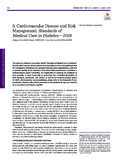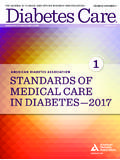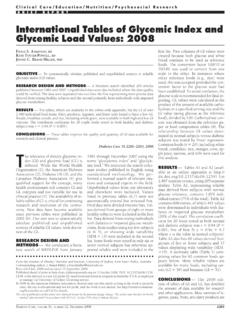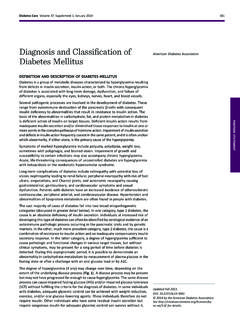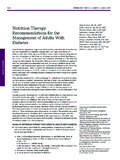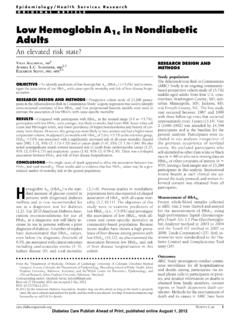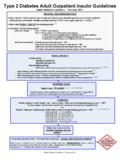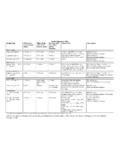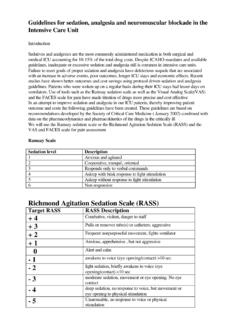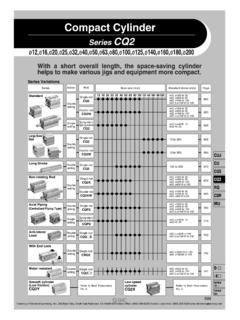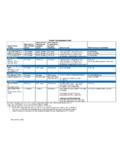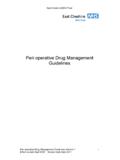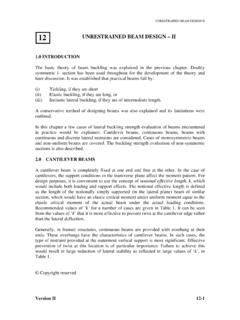Transcription of 8. Pharmacologic Approaches to Glycemic …
1 8. Pharmacologic Approaches toGlycemic Treatment:Standards ofMedical Care in Diabetesd2018 Diabetes Care 2018;41(Suppl. 1):S73 S85| American Diabetes Association (ADA) Standards of Medical Care in Diabetes includes ADA s current clinical practice recommendations and is intended to providethe components of diabetes care, general treatment goals and guidelines, and toolsto evaluate quality of care. Members of the ADA Professional Practice Committee, amultidisciplinary expert committee, are responsible for updating the Standardsof Care annually, or more frequently as warranted. For a detailed description ofADA standards, statements, and reports, as well as the evidence-grading systemfor ADA s clinical practice recommendations, please refer to the Standards of CareIntroduction. Readers who wish to comment on the Standards of Care are invited todo so at THERAPY FOR TYPE 1 DIABETESR ecommendationscMost people with type 1 diabetes should be treated with multiple daily in-jections of prandial insulin and basal insulin or continuous subcutaneousinsulin individuals with type 1 diabetes should use rapid-acting insulin analogs toreduce hypoglycemia educating individuals with type 1 diabetes on matching prandial insulindoses to carbohydrate intake, premeal blood glucose levels, and anticipatedphysical with type 1 diabetes who have been successfully using continuoussubcutaneous insulin infusion should have continued access to this therapy afterthey turn 65 years of TherapyInsulin is the mainstay of therapy for individuals with type 1 diabetes.
2 Generally,the starting insulin dose is based on weight, with doses ranging from units/kg/day of total insulin with higher amounts required during Diabetes Association/JDRF Type 1 Diabetes units/kg/day as a typical starting dose in patients with type 1 diabetes whoare metabolically stable, with higher weight-based dosing required immediatelyfollowing presentation with ketoacidosis (1), and provides detailed informationon intensification of therapy to meet individualized needs. The American DiabetesAssociation (ADA) position statement Type 1 Diabetes Management ThroughtheLifeSpan additionally provides a thorough overview of type 1 diabetestreatment (2).Suggested citation: American Diabetes Associ-ation. 8. Pharmacologic Approaches to glyce-mic treatment:Standards of Medical Care inDiabetesd2018. Diabetes Care 2018;41(Suppl. 1):S73 S85 2017 by the American Diabetes may use this article as long as the workis properly cited, the use is educational and notfor profit, and the work is not altered.
3 More infor-mation is available at Diabetes AssociationDiabetes CareVolume 41, Supplement 1, January 2018S738. Pharmacologic Approaches TO Glycemic TREATMENTE ducation regarding matching prandialinsulin dosing to carbohydrate intake,premeal glucose levels, and anticipatedactivity should be considered, and se-lected individuals who have masteredcarbohydrate counting should be edu-cated on fat and protein gram estimation(3 5). Although most studies of multipledaily injections versus continuous subcu-taneous insulin infusion (CSII) have beensmall and of short duration, a systematicreview and meta-analysis concluded thatthere are minimal differences betweenthe two forms of intensive insulin therapyin A1C (combined mean between-groupdifference favoring insulin pump therapy [95% CI to ]) and se-vere hypoglycemia rates in children andadults (6). A 3-month randomized trial inpatients with type 1 diabetes with noctur-nal hypoglycemia reported that sensor-augmented insulin pump therapy withthe threshold suspend feature reducednocturnal hypoglycemia without increas-ing glycated hemoglobin levels (7).
4 Food and Drug Administration (FDA)has also approved thefirst hybrid closed-loop system pump. The safety and effi-cacy of hybrid closed-loop systems hasbeen supported in the literature in ado-lescents and adults with type 1 diabetes(8,9).Intensive management using CSII andcontinuous glucose monitoring should beencouragedinselectedpatientswhenthere is active patient/family participa-tion (10 12).The Diabetes Control and Complica-tions Trial (DCCT) clearly showed that in-tensive therapy with multiple dailyinjections or CSII delivered by multidisci-plinary teams of physicians, nurses, dieti-tians, and behavioral scientists improvedglycemia and resulted in better long -termoutcomes (13 15). The study was carriedout with short-acting and intermediate-acting human insulins. Despite better mi-crovascular, macrovascular, and all-causemortality outcomes, intensive therapywas associated with a high rate of severehypoglycemia (61 episodes per 100 patient-years of therapy).
5 Since the DCCT, a numberof rapid-acting and long -acting insulin an-alogs have been developed. These analogsare associated with less hypoglycemia,less weight gain, and lower A1C than humaninsulins in people with type 1 diabetes(16 18). Longer-acting basal analogs(U-300 glargine or degludec) may addi-tionally convey a lower hypoglycemia riskcompared with U-100 glargine in patientswith type 1 diabetes (19,20).Rapid-acting inhaled insulin used be-fore meals in patients with type 1 diabe-tes was shown to be noninferior whencompared with aspart insulin for A1 Clow-ering, with less hypoglycemia observedwith inhaled insulin therapy (21). How-ever, the mean reduction in A1C wasgreater with aspart ( vs. ,satisfying the noninferiority margin ), and more patients in the insulinaspart group achieved A1C goals of# (53 mmol/mol) and# (48mmol/mol). Because inhaled insulin car-tridges are only available in 4-, 8-, and12-unit doses, limited dosing incrementstofine-tune prandial insulin doses in type 1diabetes are a potential glucose excursions maybe better controlled by adjusting the tim-ing of prandial (bolus) insulin dose admin-istration.
6 The optimal time to administerprandial insulin varies, based on the typeof insulin used (regular, rapid-acting ana-log, inhaled, etc.), measured blood glucoselevel, timing of meals, and carbohydrateconsumption. Recommendations for pran-dial insulin dose administration shouldtherefore be , an amylin analog, is an agentthat delays gastric emptying, blunts pan-creatic secretion of glucagon, and en-hances satiety. It is FDA-approved for usein adults with type 1 diabetes. It has beenshown to induce weight loss and lower in-sulin doses. Concurrent reduction of pran-dial insulin dosing is required to reduce therisk of severe AgentsMetforminAdding metformin to insulin therapy mayreduce insulin requirements and improvemetabolic control in patients with type 1diabetes. In one study, metformin wasfound to reduce insulin requirements( units/day,P, ), and led tosmall reductions in weight and total andLDL cholesterol but not to improved gly-cemic control (absolute A1C , ) (22).
7 A randomized clin-ical trial similarly found that, among over-weight adolescents with type 1 diabetes,the addition of metformin to insulin didnot improve Glycemic control and in-creased risk for gastrointestinal adverseevents after 6 months compared withplacebo (23). The Reducing With MetforminVascular Adverse Lesions in Type 1 Diabetes(REMOVAL) trial investigated the additionof metformin therapy to titrated insulintherapy in adults with type 1 diabetes atincreased risk for cardiovascular diseaseand found that metformin did not signifi-cantly improve Glycemic control beyondthefirst 3 months of treatment and thatprogression of atherosclerosis (measuredby carotid artery intima-media thickness)was not significantly reduced, althoughother cardiovascular risk factors such asbody weight and LDL cholesterol im-proved (24). Metformin is not FDA-approved for use in patients with type TherapiesDue to their potential protection ofb-cellmass andsuppression ofglucagon release,glucagon-like peptide 1 (GLP-1) receptoragonists (25) and dipeptidyl peptidase4 (DPP-4) inhibitors (26) are being studiedin patients with type 1 diabetes but arenot currently FDA-approved for use in pa-tients with type 1 Glucose Cotransporter 2 InhibitorsSodium glucose cotransporter 2 (SGLT2)inhibitors provide insulin-independentglucose lowering by blocking glucose re-absorptionintheproximalrenal tubule byinhibiting SGLT2.
8 These agents providemodest weight loss and blood pressurereduction in type 2 diabetes. There arethree FDA-approved agents for patientswith type 2 diabetes, but none are FDA-approved for the treatment of patientswith type 1 diabetes (2). SGLT2 inhibitorsmay have Glycemic benefits in patientswith type 1 or type 2 diabetes on insulintherapy (27). The FDA issued a warningabout the risk of ketoacidosis occurringin the absence of significant hyperglyce-mia (euglycemic diabetic ketoacidosis)in patients with type 1 or type 2 diabe-tes treated with SGLT2 of ketoacidosis include dysp-nea, nausea, vomiting, and abdominalpain. Patients should be instructed tostop taking SGLT2 inhibitors and seekmedical attention immediately if theyhave symptoms or signs of ketoacidosis(28).SURGICAL TREATMENT FORTYPE 1 DIABETESP ancreas and Islet TransplantationPancreas and islet transplantation havebeen shown to normalize glucose levelsS74 Pharmacologic Approaches to Glycemic TreatmentDiabetes CareVolume 41, Supplement 1, January 2018but require life- long immunosuppressionto prevent graft rejection and recurrenceof autoimmune islet destruction.
9 Giventhe potential adverse effects of immuno-suppressive therapy, pancreas transplan-tation should be reserved for patientswith type 1 diabetes undergoing simulta-neous renal transplantation, following re-nal transplantation, or for those withrecurrent ketoacidosis or severe hypogly-cemia despite intensive Glycemic man-agement (29). Pharmacologic THERAPY FORTYPE 2 DIABETESR ecommendationscMetformin, if not contraindicatedand if tolerated, is the preferred ini-tial Pharmacologic agent for thetreatment of type 2 use of metformin may beassociated with biochemical vitaminB12 deficiency, and periodic mea-surement of vitamin B12 levels shouldbe considered in metformin-treatedpatients, especially in those with ane-mia or peripheral initiating insulin therapy(with or without additional agents)in patients with newly diagnosedtype 2 diabetes who are symptom-atic and/or have A1C$10% (86mmol/mol) and/or blood glucoselevels$300mg/dL ( ).
10 EcConsider initiating dual therapy inpatients with newly diagnosedtype 2 diabetes who have A1C$9% (75 mmol/mol).EcIn patients without atheroscleroticcardiovascular disease, if mono-therapy or dual therapy does notachieve or maintain the A1C goalover 3 months, add an additionalantihyperglycemic agent based ondrug-specific and patient factors(Table ).AcA patient-centered approach shouldbe used to guide the choice ofpharmacologic agents. Consider-ations include efficacy, hypoglyce-mia risk, history of atheroscleroticcardiovascular disease, impact onweight, potential side effects, re-nal effects, delivery method (oralversus subcutaneous), cost, andpatient patients with type 2 diabetes andestablished atherosclerotic cardio-vascular disease, antihyperglycemictherapy should begin with lifestylemanagement and metformin andsubsequently incorporate an agentproven to reduce major adverse car-diovascular events and cardiovascu-larmortality(currentlyempagl iflozinand liraglutide), after consideringdrug-specific and patient factors(Table ).
